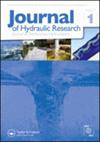主河道宽度对覆顶非粘性河堤溃决的影响
IF 1.7
3区 工程技术
Q3 ENGINEERING, CIVIL
引用次数: 0
摘要
摘要对水流漫溢引起的均质非粘性砂质河流堤防决口进行了室内试验研究。试验是在主河道、可侵蚀侧堤和洪泛区进行的。主河道宽度和漫顶前的弗劳德数有系统的变化。根据水位测量和质量守恒推导出决口流量。利用非侵入式激光轮廓测量技术获得了不断变化的缺口几何形状的高分辨率三维重建。主河道宽度和弗劳德数对溃口扩展和水流曲线有显著影响。根据弗劳德数和无量纲主河道宽度的不同,裂口水道分为三种类型。提出了一种基于“有效溃口宽度”概念的河流堤防溃口模型。利用实验室数据,计算出的决口流量是非常令人满意的,尽管模型不能准确地再现决口下游的扩展。关键词:攻破通道宽度;披露声明作者未报告有潜在的利益冲突。补充数据补充数据可以从论文的在线版本中获取。本研究由法国国家技术研究协会(ANRT) [CIFRE 2015/0015和CIFRE 2018/1235]、欧洲区域发展基金(计划opRhône-Saône 2014-2020)和EDF部分资助。本文章由计算机程序翻译,如有差异,请以英文原文为准。
Main channel width effects on overtopping-induced non-cohesive fluvial dike breaching
AbstractLaboratory experiments were conducted on the breaching of homogeneous non-cohesive sandy fluvial dikes induced by flow overtopping. Tests were conducted using a main channel, an erodible lateral dike and a floodplain. The main channel width and Froude number prior to overtopping were systematically varied. Breach discharge was deduced from water level measurements and mass conservation. High-resolution 3D reconstructions of the evolving breach geometry were obtained using a non-intrusive laser profilometry technique. The main channel width and Froude number show significant influence on the breach expansion and hydrograph. Breach hydrographs are divided into three types, depending on the Froude number and a non-dimensional main channel width. An adapted fluvial dike breaching model based on the concept of “effective breach width” is proposed. Using the laboratory data, the computed breach discharge is found extremely satisfactory, although the breach downstream expansion is not accurately reproduced by the model.Keywords: Breachchannel width; fluvial dikelaboratory experimentnon-cohesivenumerical modelovertopping flow Disclosure statementNo potential conflict of interest was reported by the author(s).Supplemental dataSupplemental data can be accessed from the online version of the paper. All experimental data are available from the following Zenodo depository: https://doi.org/10.5281/zenodo.1477843.Additional informationFundingThis work was partially funded by the Association Nationale de Recherche et de la Technologie (ANRT) [CIFRE 2015/0015 and CIFRE 2018/1235], the European Regional Development Fund (Programme Opérationnel Interrégional Rhône-Saône 2014–2020) and EDF.
求助全文
通过发布文献求助,成功后即可免费获取论文全文。
去求助
来源期刊

Journal of Hydraulic Research
工程技术-工程:土木
CiteScore
4.90
自引率
4.30%
发文量
55
审稿时长
6.6 months
期刊介绍:
The Journal of Hydraulic Research (JHR) is the flagship journal of the International Association for Hydro-Environment Engineering and Research (IAHR). It publishes research papers in theoretical, experimental and computational hydraulics and fluid mechanics, particularly relating to rivers, lakes, estuaries, coasts, constructed waterways, and some internal flows such as pipe flows. To reflect current tendencies in water research, outcomes of interdisciplinary hydro-environment studies with a strong fluid mechanical component are especially invited. Although the preference is given to the fundamental issues, the papers focusing on important unconventional or emerging applications of broad interest are also welcome.
 求助内容:
求助内容: 应助结果提醒方式:
应助结果提醒方式:


